
Originally published in The Clarinet 49/1 (December 2021). Printed copies are available for ICA members
Book and Music Reviews: December 2021
BOOKS
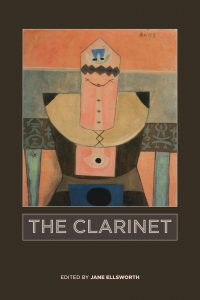 Jane Ellsworth, editor. The Clarinet. University of Rochester Press and Boydell & Brewer Limited, 2021. 297 pp. Hardcover $60.00, E-book $24.99
Jane Ellsworth, editor. The Clarinet. University of Rochester Press and Boydell & Brewer Limited, 2021. 297 pp. Hardcover $60.00, E-book $24.99
Imagine yourself in the best of moods having just heard a wonderful concert at ClarinetFest®. The conversation afterward flows with superlatives. Your group includes informed performers, music researchers and music lovers with a bent to know context and history. Thanks to Jane Ellsworth you can enjoy such excitement through the ten chapters of her most recent book. Ellsworth herself authored two chapters, the first, “From the ‘Little Trumpet’ to Unique Voice: The Clarinet in the Concert Orchestra” sketches the use of the clarinet in symphonic music. The second, “Important Clarinetists since 1900: A Concise Introduction” selectively highlights clarinetists who expanded the repertoire through commissions and recordings, those who have been important to chamber music and those who broke culturally limiting barriers.
Through her network of star contributors we are given a broad image of the most up-to-date ideas concerning the clarinet universe. Ellsworth, as editor, has succeeded in keeping the tone of the chapters level; while being accurate, they are not eruditely cumbersome. The topics and writing style will engage clarinetists of all ages, and the footnotes, bibliographic in nature, point the motivated researcher further afield.
Erich Hoeprich’s chapter illustrates and explains the history of clarinet iconography. Albert R. Rice focuses on the complementary and contrasting use of chalumeau and clarinet before Mozart. Ingrid E. Pearson explores the role of the clarinet in opera before 1830 in Paris, London, Naples and Vienna. Continuing the exploration of the clarinet in opera, Julian Rushton relates the effective use of the clarinet as “voice” in 19th-century stage works. David E. Schneider’s contribution “Innovation and Convention in the Golden Age of the Clarinet Concerto, ca. 1800-1830” reveals the workings of musical forms in relation to virtuosic display in many of our most popular works. I found his chapter especially stimulating. Marie Sumner Lott’s chapter examines the core repertoire of the clarinet quintet from Mozart through
Meyerbeer, Weber and Baermann to Brahms. Colin Lawson contributes his latest thoughts concerning “historically intelligent” performance – a topic that reveals new directions every decade. The final chapter, by S. Frederick Starr, “The Clarinet in Vernacular Music” helps us understand the clarinet in the broader world with all its truthful social and geo-political connections. His subheadings –
“The Austrian Clarinet Diaspora,” “The Vernacular Clarinet in the Caribbean World and Mexico,” “The Vernacular Clarinet in the United States and New Orleans,” “The Golden Age: The Virtuoso Vernacular Clarinet in the Twentieth Century” and “A Gentle Afterlife” – hint to the mind-opening ideas that will be shared with you.
This is a unique volume that is contemporary in tone and message while standing on the firmest of research foundations.
– Gregory Barrett
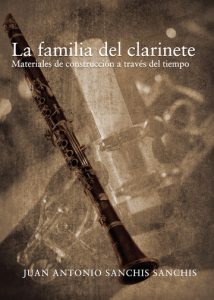 Juan Antonio Sanchís. La familia del clarinete: Materiales de construcción a través del tiempo (The Clarinet Family: Construction Materials through Time). Punto Rojo Libros S. L. (www.puntorojolibros.com). 115 pages. In Spanish. E-book: €2,85/$3.38
Juan Antonio Sanchís. La familia del clarinete: Materiales de construcción a través del tiempo (The Clarinet Family: Construction Materials through Time). Punto Rojo Libros S. L. (www.puntorojolibros.com). 115 pages. In Spanish. E-book: €2,85/$3.38
Did you know that today it is possible to acquire mouthpieces in at least five different materials, including gold? And also that the ligature has been made in almost every imaginable material? And
for the main body, not less than 10 different materials?
In his book La familia del clarinete, Juan Antonio Sanchís shows us all of this and more. The author makes a concise description of each of the materials that have been used over the years to manufacture the different parts of clarinets, from the most common, like wood or metal, to the least used, like ivory or carbon fiber.
Sanchís’s book confirms two things: for more than 300 years, almost every material to manufacture a clarinet has been tried, and many of the products and accessories currently on the market as a novelty are nothing less than a version of something that was done decades or even centuries ago. In short, I highly recommend this book for everybody who wants to know the little-known facts of our instrument.
The author completed his musical studies in Valencia. He has been a high school teacher in Isla de la Palma and teacher of chamber music in the Conservatorio Profesional de Música in Tenerife. Currently, Juan Antonio Sanchís is clarinet professor at the Conservatorio Superior de Música de Canarias in Tenerife (Spain).
– Pedro Rubio
(Spanish Version)
Juan Antonio Sanchís. La familia del clarinete. Materiales de construcción a través del tiempo. Punto Rojo Libros S. L. (www.puntorojolibros.com). 115 páginas. En español. E-book €2,85/$3.38
¿Sabías que actualmente se pueden adquirir boquillas en al menos cinco materiales distintos, incluido el oro? ¿Y que para la abrazadera se ha empleado casi cualquier material imaginable? ¿Y para el cuerpo central no menos de diez materiales diferentes?
En su libro La familia del clarinete, Juan Antonio Sanchís nos descubre todo eso y mucho más. El autor hace una descripción concisa de cada uno de los materiales que han servido a través de los años para fabricar las diferentes partes que componen los clarinetes, desde los más comunes, como la madera y el metal, hasta los menos usuales, como el marfil o la fibra de carbono.
Tras la lectura del libro es interesante constatar dos cosas: que a lo largo de más de 300 años, se ha probado con prácticamente cualquier material para fabricar un clarinete, y que muchos de los productos y accesorios que actualmente aparecen en el mercado como novedad no son más que una versión de algo que ya se hizo décadas e incluso siglos atrás. En definitiva, un libro muy recomendable para todo el que quiera introducirse en un apartado poco conocido de nuestro instrumento.
El autor realizó sus estudios musicales en Valencia. Ha sido profesor de Educación Secundaria en la Isla de La Palma y profesor de música de cámara en el Conservatorio Profesional de Tenerife. Actualmente Juan Antonio Sanchís es profesor de clarinete en el Conservatorio Superior de Música de Canarias en Tenerife.
–Pedro Rubio
MUSIC
TECHNICAL STUDIES AND ETUDES
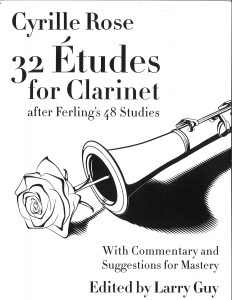 Cyrille Rose. 32 Études for Clarinet. Edited by Larry Guy. Rivernote Press, 2021. $25.00
Cyrille Rose. 32 Études for Clarinet. Edited by Larry Guy. Rivernote Press, 2021. $25.00
Many clarinetists may wonder why we need another edition of the Rose 32 Études for Clarinet. However, after inspecting this second edition by Larry Guy, we may find ourselves thinking that we don’t need it, but we definitely want it.
First, this edition is spiral bound, printed on heavy 9 by 12 paper, and is therefore easier to read and more durable than most other versions. The main source influencing Guy’s editing was the earliest edition of the Rose, published by Evette & Schaeffer in 1893, and he includes many of Daniel Bonade’s dynamic and articulation suggestions.
The book begins with a brief history of the Rose Études and a description of their structure. Next there is a clear explanation of the fingerings marked throughout the book, and justification for when to use which fingering. Guy then provides a section titled “Fundamentals of Phrasing,” in which he describes different ideas behind choosing phrase shapes. Interspersed among all of this are quotes from influential musicians such as Robert Marcellus and Marcel Moyse. Most uniquely and importantly, each etude in this book is accompanied by a full page of instruction on the etude. These pages give suggestions on things like phrasing or articulation, as well as discussing corrections made from the first edition. All of these elements open a window into studying with a master like Guy, making this edition a wonderful resource for students and professionals alike.
– Madelyn Moore
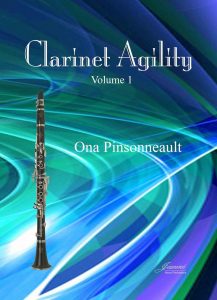 Ona Pinsonneault. Clarinet Agility, Vols. 1 and 2. Jeanné Music Publications, 2010. Each $11.95
Ona Pinsonneault. Clarinet Agility, Vols. 1 and 2. Jeanné Music Publications, 2010. Each $11.95
Jeanné Music Publications supplies a wide variety of music for clarinet in its catalog, including both traditional repertoire and new pieces, plus pedagogical material. Selections comprise music for clarinet choir and smaller clarinet ensembles, chamber music featuring clarinets along with other instruments, solo pieces for low clarinets, arrangements of folk music, and transcriptions of classical literature from the 18th through 20th centuries. Thus, for those looking to expand their repertoire, the publisher’s inventory is well worth exploring.
Ona Pinsonneault’s Clarinet Agility provides one example of pedagogical material from the publisher’s collection. In this 2010 two-volume offering, Pinsonneault expands upon the “Daily Exercises and Scales” for clarinet by Gabriel Parès (1860-1934) with its variety of articulation patterns in keys up to four sharps and flats. Pinsonneault’s Volume 1 presents studies in major and harmonic and melodic minor keys up to four flats and three sharps. Volume 2 continues in this fashion, furnishing exercises in the remaining major and minor keys up to seven sharps and flats, as well as exercises for chromatic, whole tone, pentatonic, and diminished or octatonic scales. The author provides explanations of the theory behind the scales in the beginning of each volume, and the exercises, which extend to altissimo GÏ at times, are clear and easy to read. Aside from some compound meter studies for chromatic scales, the volumes feature duple meters exclusively. There are no awkward page turns. The work is particularly beneficial in its exercises for less commonly studied scales, and, as such, it would be a useful addition to an intermediate clarinetist’s library.
– Lacey Golaszewski
 Antonio Fraioli. Dieci Studi. http://free-scores.com, 2017. Free (digital download)
Antonio Fraioli. Dieci Studi. http://free-scores.com, 2017. Free (digital download)
In Dieci Studi, composer and clarinetist Antonio Fraioli offers 10 advanced etudes that aim to stimulate improvement in many crucial areas: legato, interpretation of various articulations, flexibility through registers and rhythmic changes, embellishments, and technical facility in less-familiar keys or harmonic areas. Fraioli, a professor at the Salerno State Conservatoire, dedicates these 10 etudes to clarinetist Piero Vincenti, who encouraged him to compose the collection.
The etudes themselves present as pleasantly tonal or tonally referential, though Fraioli’s harmonic progressions frequently take unexpected turns (not unlike the twisty tonality employed by Alfred Uhl in his well-known 48 Studies). Clarinetists will also encounter whole tone and augmented patterns in various iterations. Fraioli’s background in jazz – his initial studies were in clarinet performance and jazz at the “O. Respighi” Conservatoire in Latina – shines through in several of the etudes that explore seventh and ninth chords; the motives in the seventh etude, in particular, manifest a delightful jazz influence.
In a market saturated by etudes, Fraioli distinguishes his collection by combining his keen compositional skills and an ineluctable knowledge of the clarinet. The Dieci Studi target potential weaknesses (awkward or unfamiliar finger patterns, articulations, intervals, etc.) while preserving a sense of self-awareness that keeps them idiomatic. The music, meanwhile, moves in meaningful phrases, providing ample opportunity for expression. Fraioli intentionally omits breath marks, leaving the performer maximum freedom to decide where and whether to break phrases or employ circular breathing. Considering the price (free), advanced clarinetists have no excuse not to get to work. In addition, the Dieci Studi have received an excellent reference recording on YouTube by Italian clarinetist Gabriele Coggi.
– Matthew Nelson
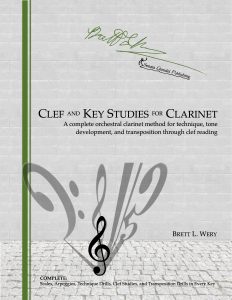 Brett L. Wery. Clef and Key Studies for Clarinet. Sonata Grendel Publishing, Scotia, NY, 2021. Print edition $46.95, digital download $35.95
Brett L. Wery. Clef and Key Studies for Clarinet. Sonata Grendel Publishing, Scotia, NY, 2021. Print edition $46.95, digital download $35.95
American composer and arranger Brett L. Wery’s Clef and Key Studies for Clarinet is a comprehensive method for learning to transpose at sight by developing clef reading skills beyond treble clef. Wery presents a systematic approach to gaining fluency in alto, tenor, mezzo-soprano and bass clefs to handle common orchestral transpositions (e.g. playing D clarinet parts on EÌ clarinet, playing bass clarinet bass clef parts in A on bass clarinet in BÌ).
After a thorough guide about how to use his text, Wery divides the major and minor keys into three groups based on diminished seventh chords. This change from the typical organization via circle of fifths lends itself to variety while practicing. Within each key, Wery provides scales and arpeggios, technique drills, clef studies and transposition drills. The scales and arpeggios include basic and full-range scales (natural, harmonic and melodic versions for minor); triads; thirds; scale in trills; supertonic, dominant and leading-tone seventh chords; and chromatic scale.
Following the scales and arpeggios, Wery incorporates clef reading in each key. The technique drills address all common clefs in brief exercises similar to those found in Kroepsch’s 416 Studies, albeit with greater rhythmic and melodic variety. In the clef studies, Wery rewrites different melodies from orchestral, opera and chamber music literature in non-treble clefs, with the first few measures also in treble clef to help clarinetists start on the correct pitches. The transposition drills feature a single melody written in all clefs, illustrating the difference between a printed part and what the transposing clarinetist would play in different situations.
Wery includes indexes of the various musical works used in this text, scales and arpeggios by initial pitch, clefs and meters. This makes it very easy to find exercises that address a specific skill or concept. There is also an introductory video available on Wery’s YouTube channel. Clef and Key Studies for Clarinet is a valuable resource for all clarinetists, but especially for those that want to take their transposing skills to the next level.
– David Cook
CLARINET WITH PIANO OR GUITAR
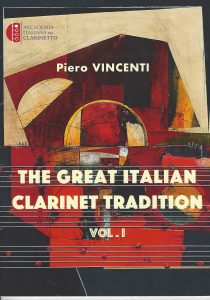 Piero Vincenti, editor. The Great Italian Clarinet Tradition, Vol. 1, The Italian “Belcanto.” Fano, Pesano-Urbino, 2020. 23 pp. www.accademiaitalianaclarinetto.com €10,00
Piero Vincenti, editor. The Great Italian Clarinet Tradition, Vol. 1, The Italian “Belcanto.” Fano, Pesano-Urbino, 2020. 23 pp. www.accademiaitalianaclarinetto.com €10,00
This is a selection of eight solos all from published clarinet solos or exercises written in a florid, “belcanto” style, particularly popular from the mid-19th century through the mid-20th century. The composers are among the most outstanding and brilliant Italian clarinetists of their day, and one trombonist and composer is also included: Luigi Bassi (1833-1871), Giovacchino Bimboni (1810-1895), Giovanni Bimboni (1813-1893), Pompeo Cavallini (1809-1884), Gaetano Lebanchi (1829-1908) and Giuseppe Marasco (1860-1930). The historical and biographical notes are written by Adriano Amore, the most important scholar of the clarinet and clarinetists in Italy, and Piero Vincenti chose the solos and carefully edited them for this volume.
The selections are excellent examples of clarinet music for the pleasure and joy of playing and hearing their well-written and idiomatic themes and phrases. They are full of technical challenges that invite players to extend themselves by working on the passages and perfecting them. The virtuosity that is required to play them at the correct tempo and with a deep understanding of the musical content is worth the extra practice and repeated performances. Piero Vicenti is congratulated for his astute choices of solos and exercises that highlight the creativity of these six Italian musicians. This volume is highly recommended for all advanced clarinetists.
– Albert R. Rice
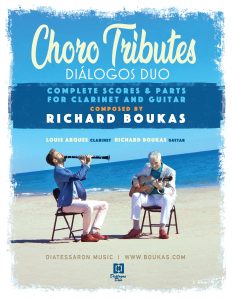 Richard Boukas. A Dozen Choro Tributes. Diatessaron Music/boukas.com, 2020. Play-along bundle $25.00, pdf or print scores: $20.00 or $25.00
Richard Boukas. A Dozen Choro Tributes. Diatessaron Music/boukas.com, 2020. Play-along bundle $25.00, pdf or print scores: $20.00 or $25.00
Richard Boukas, composer, has contributed 12 “choro-type” pieces for clarinet and guitar that are a welcome addition to the clarinet repertoire. Composed for his Diálogos Duo, with Louis Arques on clarinet, the works appear on their CD recording titled A Dozen Choro Tributes. One composition is for solo guitar. Most of the pieces are dedicated to famous choro performers and composers such as Pixinguinha, Jacob do Bandolim, Ernesto Nazareth, Villa-Lobos, Paulo Moura and Gnatali among others. The styles include samba-choro, waltz, and lament with lyrical and technical passages typical of choro vocabulary. Some of the pieces have high technical demands for the clarinet, although quite playable, with the clarinet range reaching a concert A in the altissimo. The compositions are not unlike traditional choros with their high demand of breath control, endurance and difficult technique. Boukas writes the clarinet parts for both A and BÌ clarinets, depending on the particular key of the choro.
Articulations are clearly designated and can be interpreted further according to the style. The musical style in each piece is clearly indicative of who it is dedicated to, which is impressive and inspiring to hear. This is a great credit to Boukas’s talent and creativity. Writing as a performer of choro since 1996, these pieces are a great addition to our clarinet repertoire, with the style and compositional intuition of Boukas. His attention to harmony, rhythm, balance, and style, create a unique familiarity within the choro genre, along with the respect and tribute to those great Brazilian performers and composers who we all are indebted to. We owe Boukas a hearty thank you.
The music is available via download or printed hard copy. The play-along bundle includes pdfs of the clarinet and guitar parts, audio tracks with clarinet left channel and guitar right channel isolation. There is a user guide for changing tempo, key, and the looping of segments with the audio app of your choice.
– Maurita Murphy Marx
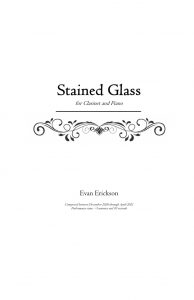 Evan Erickson. Stained Glass. Self-published, 2021. $20.00
Evan Erickson. Stained Glass. Self-published, 2021. $20.00
Evan Erickson is an 18-year-old clarinetist and composer from Dubuque, Iowa. He began composing during his freshman year of high school and lists the music of Igor Stravinsky and John Adams as his inspiration. Although just beginning his career, Erickson has already written several short works which are available for purchase from his website (www.EvanEricksonMusic.com) including an orchestral work commissioned by the Dubuque Symphony Orchestra. This fall, Erickson is headed off to the University of Memphis to study music industry. There he will join the clarinet studio of Robyn Jones and composition studio of Kamran Ince.
Stained Glass for clarinet and piano is a short, capricious work written for Erickson’s father as a special gift before Erickson left to attend college. According to Erickson’s website, Stained Glass was initially planned as a two-movement sonata, but the first movement developed into its own standalone work. It is in ABA form with an opening section that explores two contrasting ideas. One is percussive and giddy, featuring double-dotted eighths, 32nd notes and quick triplets; the other is light and articulate, featuring 16th notes that explore the clarinet’s range including the upper clarion and altissimo. The clarinet and piano play off one another until the music relaxes and slows to the more lyrical and fluid middle section. Although more soulful, this B section still contains flashes of the opening flourishes and articulations. A low trill and grand scalar flourish launch the piece back into the opening A material which then dissolves into a contemplative ending, recalling the introduction.
Stained Glass is an engaging work for performer and audience alike which comes in at just over 5 minutes in length. Keep an eye out for this young composer; I’m sure we can expect to see much more from him. Stained Glass can be purchased from Erickson directly as a digital download from his website.
– Zachary Dierickx
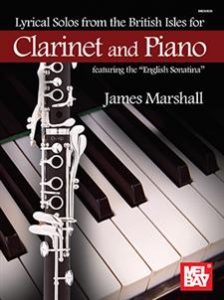 James Marshall. Lyrical Solos from the British Isles for clarinet and piano. Mel Bay Publications, 2020. $17.99
James Marshall. Lyrical Solos from the British Isles for clarinet and piano. Mel Bay Publications, 2020. $17.99
Lyrical Solos from the British Isles is a collection of short, easy pieces based on traditional English folk music, arranged by James Marshall. It includes recognizable favorites such as Scarborough Fair, Be Thou My Vision and Flow Gently, Sweet Afton. All of these are arranged for clarinet and piano with the young clarinetist in mind.
Also included in this collection is James Marshall’s English Sonatina. This is a four-movement work written in a modal, folk-song-like style that is at home among the sonorities of the traditional pieces. The rhythmic and technical difficulty of the English Sonatina make it appropriate for third or fourth-year players; it is accessible for students.
Both the clarinet and piano parts are easy to read and are bound in a substantial book. This will be an excellent resource for private teachers and young clarinetists looking for variation from the usual beginner solo collections.
– Madelyn Moore
CLARINET DUOS AND BASS CLARINET DUOS
 Antonio Romero y Andía. 26 dúos, arranged by Pedro Rubio, for two bass clarinets, basset horns or contrabass clarinets. Bassus Ediciones, 2020.
Antonio Romero y Andía. 26 dúos, arranged by Pedro Rubio, for two bass clarinets, basset horns or contrabass clarinets. Bassus Ediciones, 2020.
Free download.
Composed by Romero for his 1873 Bassoon Method, these short, medium-easy duets have been given a second life for budding bass clarinetists by arranger Pedro Rubio. Romero (1815-1886) writes in a melodic/harmonic style akin to Rose, and Rubio builds on this familiarity to give low C bass clarinetists music to master French and German notation conventions. Each duo is written first in the French manner in treble clef and then in the German reading in bass clef.
The music is presented with the top and bottom parts on the same page, with each duo one to two pages in length. Their short nature invites sight reading with student and teacher and each is an excellent setting to explore the intricacies of intonation in bass clarinet playing. The parts are fairly equal, with the bottom one utilizing more of the extended low range. Musically satisfying, a few of the longer duos could be grouped in a suite for recital performance for bass clarinetists. Highly recommended.
– Gregory Barrett
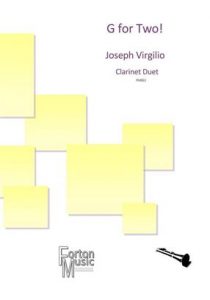 Joseph Virgilio. G for Two! Forton Music, 2020. Print edition £8.00, digital download £6.00
Joseph Virgilio. G for Two! Forton Music, 2020. Print edition £8.00, digital download £6.00
Joseph Virgilio (b. 1951) studied music from a young age and began his adult life as a composer but then left music for an alternate career. Upon his retirement he returned to composition and has recently published G for Two!, a duet in three movements for two young clarinetists.
In a note on the first page of the publication, Virgilio says that this work is “intended to add some spice for young ears, to enable them to hear more than just the traditional way of traversing the sound palette, going beyond that found in the typical music compositions for early players.” Indeed, this simple duet does provide some surprising shifts in harmony, but remains accessible to young listeners. Furthermore, it is full of opportunities to develop other important skills for young students. The range never crosses into the altissimo, and none of the movements are written at a tempo that would be prohibitive for students.
The first movement, marked Adagio meno mosso before transitioning to Andante, consists primarily of a lyrical line in the first clarinet, with some tricky 16th and eighth note rhythms in the second clarinet. This would present a nice challenge for second and third-year players, both in terms of part independence as well as rhythm.
The second movement, Allegro piu mosso, sounds ethereal, and provides a good opportunity for the aural stretching that Virgilio discussed in the introduction to the piece. It also highlights changes
in articulation and style – going from slurs to staccato eighth notes – and includes grace notes.
Finally, the third movement, Allegro ma non troppo, gives several opportunities for rubato, ritardando, fermata and caesura. In addition to the stylistic, rhythmic and ornamental lessons that could be taught with the first movement, it would be an excellent resource for teaching students the communication skills necessary for chamber music.
– Madelyn Moore
 Karen Gourlay. Dazzling Duos – Grade 2 Clarinet. Forton Music, 2019. Print edition £8.00, digital download £6.00
Karen Gourlay. Dazzling Duos – Grade 2 Clarinet. Forton Music, 2019. Print edition £8.00, digital download £6.00
Karen Gourlay is a flutist who originally studied jazz at Leeds College of Music. She now enjoys a career both as a teacher at her alma mater and as an award-winning composer. Gourlay’s Dazzling Duos is a charming collection of 10 short duets for young players.
These duets are an ideal teaching tool because they incorporate many challenging skills for students. The first part in most of the duos crosses the break into the clarion register, but never into the altissimo. Therefore, these would be best suited for first- and second-year students.
Rhythmically, the challenge varies between each duo. Most of them focus on quarter note and eighth note rhythms in duple meter. However, a few of the duos incorporate dotted-quarter eighth note patterns, and one of them is in 6/8 time with both triplets as well as quarter note/eighth note lines. This is an excellent resource for presenting these skills to students for the first time.
These duets will assist teachers in guiding students through developing stylistic playing habits. Gourlay makes good use of dynamic variation, as well as changes in articulations. The students’ musicality and listening skills will be helped by the fact that there are duets both in major and minor keys. This collection of duos is a welcome and pleasant addition to any private clarinet teacher’s library.
– Madelyn Moore
MIXED CHAMBER MUSIC
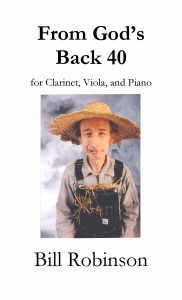 Bill Robinson. From God’s Back 40 for clarinet, viola and piano. Second Edition. Parrish Press, Cleveland, North Carolina, 2019. billrobinsonmusic.com Free download.
Bill Robinson. From God’s Back 40 for clarinet, viola and piano. Second Edition. Parrish Press, Cleveland, North Carolina, 2019. billrobinsonmusic.com Free download.
As his notes indicate, Bill Robinson composed From God’s Back 40 for clarinet, viola and piano in 2017 at the request of clarinetist Fred Jacobowitz and pianist Carl Banner. The piece derives its title from the rustic environment in which Robinson created the piece in Cleveland, North Carolina, after he had relocated to the area from Raleigh. With a performance time of about 28 minutes, the work is in four movements. All of the movements feature imitative writing, and repeated tones are infused throughout. The first of the movements, “Gimme that Old-Time Tetrachord,” focuses on the tetrachord, a staple in the composer’s music, and it clocks in just shy of 8 minutes in length. Interspersed among the brighter segments are dolce sections that frequently provide opportunities for the clarinet to sing. The 6-minute second movement, “Yet Another Waltz,” follows, its appellation drawing attention to the composer’s apparent affinity for waltzes. This movement is a quick waltz, with articulation patterns providing a hemiola effect. In the third movement, ‘Sic Transit Mundi,” the tempo relaxes to lento at dotted quarter note = 46 in compound meter. Meter changes abound throughout the 7 ½-minute movement, in which the sicilienne rhythm is also prominent. At 5 ½ minutes, “The Albuterol Stomp” rounds out the set. Named after the composer’s COPD medication, the movement lives up to its title’s stimulating implications.
The score and parts are easy to read with no awkward page turns for the clarinetist or violist, although the pianist would almost certainly require a page turner. The clarinet part requires a range up to an altissimo G and thus would mandate a moderately advanced performer at minimum. That the clarinet and piano parts tend to obscure the viola at times in terms of balance is but a minor drawback of the work; the piece would nevertheless be a welcome contemporary addition to the repertoire for this instrumentation.
– Lacey Golaszewski
CLARINET QUARTETS
 Kyle Hovatter. under the Presence, whatever there is else is moving. Forton Music, 2019. Print edition £12.00, digital download £9.00
Kyle Hovatter. under the Presence, whatever there is else is moving. Forton Music, 2019. Print edition £12.00, digital download £9.00
San Francisco-based composer Kyle Hovatter (b. 1986) strives to create compositions for unusual instruments. At first glance, his work for four bass clarinets, under the Presence, whatever there is else is moving, does not seem particularly unusual. However, upon closer study, one can hear that it is indeed a unique composition.
The title of the work is taken from a poem by William Carlos Williams (1883-1963), which also serves as the inspiration for the construction of the piece. Hovatter says that he has “attempted to capture that same sensation of attention being given to what is not in the foreground … The goal is for the listener (and especially the performers) to notice what cannot
be notated.”
The piece itself consists of tone clusters achieved by long notes in all four parts that move at different times. It results in an ethereal effect and provides for slow, but interesting changes in the harmony. It should be noted that all parts include extreme altissimo notes, so the work is best performed by an advanced ensemble. The overall effect of the piece moves between peaceful and unsettling. It is a thought-provoking, enjoyable work that would be an interesting addition to a recital.
– Madelyn Moore
 Marc Mellits. No Exit for two clarinets and two bass clarinets. Dacia Music, 2021. Score and parts $75.00
Marc Mellits. No Exit for two clarinets and two bass clarinets. Dacia Music, 2021. Score and parts $75.00
Since 2008 and the premiere of his two bass clarinet work Black, Chicago composer Marc Mellits has had an avalanche of fans. No wonder he has responded with over two dozen chamber music works including clarinet or bass clarinet. The latest, No Exit, was commissioned by clarinetist Bruce Belton and composed during the Covid pandemic. Mellits – whose current style can be categorized as postminimalist with characteristic prolonged harmonies, varying uncomplicated rhythmic textures and contrasting formal sections – has created a quartet that is an antidote for the pandemic. Minor and major key tonalities flourish, dissonance is mild, music with a sense of motion alternates with slower contemplative sections and a somber yet peaceful closing becomes a spiritually fulfilling remedy.
At approximately 21 minutes in duration, No Exit is an endurance test of concentration and embouchure. Mellits includes suggested tempos but endorses a range of possibilities – this fact and that almost all the music stays within tonalities of one flat and that the parts have conservative altissimo writing allows performance by a wide range of players. Playing No Exit is a team event due to the equal parts. Interlocking 16th notes will test rhythmic expertise and both bass clarinetists need an extended range instrument. This is music to compete with pop music whether in an informal setting or in a concert hall.
– Gregory Barrett
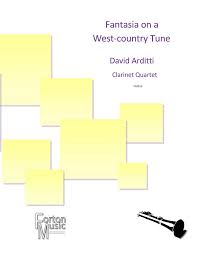 David Arditti. Fantasia on a West-Country Tune. Forton Music, 2020. Print edition £12.00, digital download £9.00
David Arditti. Fantasia on a West-Country Tune. Forton Music, 2020. Print edition £12.00, digital download £9.00
David Arditti’s works include all genres, among them clarinet concerto, and are especially well known for accessible, intermediate-level essays such as this quartet for two BÌ clarinets, alto clarinet (alternate BÌ clarinet part included) and bass clarinet. Perfect for middle school ensembles and up (no extended range needed on bass clarinet), the brief Fantasia features four tempo sections, solo or soli opportunities for each performer, a 16-measure section of duple versus compound meter and a pleasing sequential circle of fifths passage, all cast within a tuneful British folksong style.
– Gregory Barrett
Comments are closed.